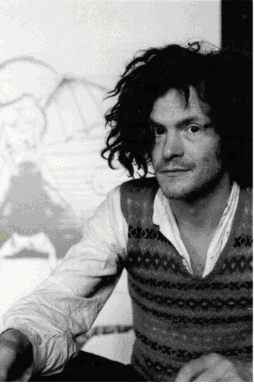
Text and photo of HW: Jay Jeff Jones
King’s Road, London in early December 1974…a dank, bleak day where everyone I passed seemed to wear the same stroppy, deflectional look, alone together in their disenchanted metropolitan lives. I was walking West but can’t now remember where I was heading or even why I had come down from Manchester. When a figure appeared in the distance, the first things I recognised were a curious vitality and antic hair. The attire was a shapeless antique tweed overcoat and badly fitting, broken down / platform-soled disco shoes, creased check trousers and collarless shirt. Every stitch was charity-shop; although not charity-shop vintage panache, the inventive cool of Jay and Fran Landesman, and not the charity-shop of last season’s designer castoffs. This vagrant raffishness was a found-in-the-skip, anti-style, Punk ensemble that made the Sex Pistols look like a fairy queen picnic party. He approached quickly but precariously, face animated with private amusements. It was Heathcote Williams.
He invited me to reverse direction and join him for a rehearsal of his new play Remember the Truth Dentist at the Royal Court Theatre. Several years before, in almost the same circumstances, I had to decline a similar invite for a rehearsal of the revival of AC/DC. This time, my time was my own, and I was happy to head back towards Sloane Square.
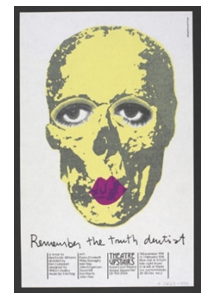 After AC/DC, the course of Heathcote’s writing would be set by the purging of that play’s personalities from his head. He explained in an interview with Irving Wardle that the final scene, the trepanation of Perowne, which caused the character’s expressions and speech to become non-cognitive, had “cured” him of the play; as if stage directing the opening of a skull had released the negatively charged, squabbling genies trapped in the author’s own head. “I rented by brain out to five characters with separate resonance fields and their own perceptions and rhythms. Often, they got muddled up into a group mind, which was something else I wanted to convey. Character as usually portrayed on the stage is hopelessly stratified.”1
After AC/DC, the course of Heathcote’s writing would be set by the purging of that play’s personalities from his head. He explained in an interview with Irving Wardle that the final scene, the trepanation of Perowne, which caused the character’s expressions and speech to become non-cognitive, had “cured” him of the play; as if stage directing the opening of a skull had released the negatively charged, squabbling genies trapped in the author’s own head. “I rented by brain out to five characters with separate resonance fields and their own perceptions and rhythms. Often, they got muddled up into a group mind, which was something else I wanted to convey. Character as usually portrayed on the stage is hopelessly stratified.”1
Joseph McCrindle, the publisher of Transatlantic Review, told me in 1967 that Heathcote was in the middle of writing a “big and important” play, but was struggling to get it finished. Joe used a phrase something like, “Heathcote wants the play to ‘set him up’”, which we both took to mean cementing his reputation or providing financial independence; a bit like Loot had done for Joe Orton. That only shows how little idea we had.
In the end it took four years and a dozen or more drafts before AC/DC was submitted to the Royal Court. Everyone there who read it was so perplexed at the unprecedented style, enigmatic vocabulary and typographic-character-coded script, that it sat in a corner gathering dust for another year.
When given a low-key production in the studio space in May 1970 the play made such an impact it was scheduled for a second run in the main house, appended to the end of Come Together, an alternative theatre festival. Only a year later it was revived again. The acclaim of Katherine Worth, who collaborated with Samuel Beckett and became Britain’s first female Professor of Drama, was exact, “…there is such a strong sense of occult purpose, of language as an element in a monstrous ritual of purification, exorcism and transcendence…”2
Only the three most articulate and intricate characters in AC/DC – Maurice, Perowne and Sadie – who nimbly swap wavelengths with one another, also appear in the long second act. This fits with one of the play’s key sources, a psychiatric experiment where three paranoid schizophrenics, each believing that he was Jesus Christ, were kept together in a hospital in Michigan.3 The patients were manipulated by a psychiatrist to see whether their messianic delusions would converge or conflict, which would possibly provoke a recovery. From the published case study Heathcote extracted some phrases and notions for the play, including the idea that one person could direct words or psychic energy to “hollow out” another and the use of electrical metaphors for human interaction.4
AC/DC’s schizoid trio are similarly emmeshed. And whether they are prophets, karmic avengers or simply first-class wackos with uninsulated neurotic egos, they are all overloaded with media irradiation and the toxic contagion of celebrity culture. Their aggravated sexuality is more desperate than transgressive. It’s also a tactical weapon in their hyper-articulate, psycho-electric mutiny, directed against all forms of mind control. This not only includes conventional psychiatric intervention but an intention to smash “the whole psychophagic powerhouse”. Maurice is particularly enraged by what was (at the time of its writing) the well-publicised and “sexed-up” theories of R D Laing with his interest in what he calls “only the most decorative schizos…only the most picaresque.” 5
For a play that begins with a three-way cluster-fuck in a photobooth and features solo and assisted masturbations, it takes a committed and fearless cast to carry it off. Regardless of infrequent revivals the renown / infamy of AC/DC has endured down the years, blessed with Charles Marowitz’s snappy description as it as “the first play of the 21st century”.6 In 1999 a performance was included in the National Theatre’s platform festival of the 20th century’s most “significant” plays. A Guardian review concentrated on the play’s headline theme, the vampiric nature of fame, as a, “…force that feeds off the rest of us by diverting the care and attention we owe each other onto celebrities.”7 This only partially explains the audacity of a play where the stage is swamped in predictive entrails, foretelling a “psychic capitalist” dystopia.
When Susan Sontag wrote about Artaud’s subversion of the theatre and his defections from its merely “aesthetic currents”, she listed the writers, ideas and works of the early 1970s that she thought had responded. The list included Jean Genet, Fernado Arrabal, Happenings, the Living Theatre’s Frankenstein, Michael McClure’s The Beard, Robert Wilson’s Deafman Glance and, of course, AC/DC.8
Despite its reputation, it would be wrong to say that AC/DC took London theatre by storm. When the original production transferred to the Royal Court’s main house it ran for only 16 performances, selling just 32% of the seats, the lowest percentage of that year’s productions. After recovering the miniscule budget of £1,326, it returned a gross profit of £52.9 Despite that, the people who mattered took notice, including critics and award committees. The New York production became the Village Voice’s “Play of the Year”. Heathcote declared that in any case, his preoccupations had moved on and he would concern himself with being “an optimist, an Anarchist and a Utopian. I hope the next thing I do will be able to get that side through customs…Now I want to create a habitable environment, where the audience will stop the play after five minutes because they’re radiated by all the good vibes.”10
The initiation rite of the Living Theatre’s Paradise Now had once made that kind of promise, despite performances eventually becoming the hip bourgeoisie’s favourite daring night out. For a while, touchy-feely interaction and mingling between performers and audience became a routine underground theatre thrill. Heathcote still hoping that players and watchers might fuse into a life-changing, euphoric ball of delights, was a measure of his optimism.
<>
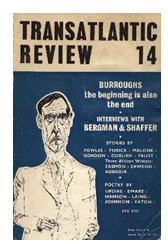 In the autumn of 1963 Heathcote had been appointed contributing editor of the Transatlantic Review (TR) and asked to design the cover of an issue that featured a story by William Burroughs. He arranged to meet Burroughs at his hotel in Bayswater so that he could sketch a portrait. The meeting led to an enduring friendship, but Heathcote’s final line drawing of Burroughs was based on a photograph taken in Paris by Brion Gysin.
In the autumn of 1963 Heathcote had been appointed contributing editor of the Transatlantic Review (TR) and asked to design the cover of an issue that featured a story by William Burroughs. He arranged to meet Burroughs at his hotel in Bayswater so that he could sketch a portrait. The meeting led to an enduring friendship, but Heathcote’s final line drawing of Burroughs was based on a photograph taken in Paris by Brion Gysin.
TR was one of the places that fragments of the Truth Dentist began to appear in 1973. His “Death” poem had appeared in TR 48, also ending up in several other publications including, uncredited, in the last issue of OZ magazine. Death was dissected in 37 ways, such as: “Death stockpiles the chemistry of your smiles” and “Death is passion being drip fed to sentiment”. In the magazine’s authors’ notes his new work in progress was signalled when he declared that, “HEATHCOTE WMS is one of the ninety-nine names of the Truth Dentist.”
“Plant Liberation”, another Truth Dentist extract ran in TR 50, published as the play was being produced. Its Arcadian jam session on the Earth’s vegetation was a warmup for the later book-length poems on humanity’s wretched relationships with whales and elephants. He then described The Truth Dentist as “a revue for one man”.
At the Royal Court, the play’s director, Ken Campbell, had elected to displace the veritable Truth Dentist with six actors and a musician and once or twice I got the idea that the playwright had mixed feelings.
When we arrived, the rehearsal was underway in the Theatre Upstairs studio, where it would be performed. The seats had been cleared from the audience space, so the actors could work. Behind them, the small stage was filled by a grand piano, a feature of the current show; also billed as a “revue”. It was a showcase for Hinge and Brackett, a cross-dressing double act in the naughty-but-nice, skittish innuendo tradition of British comedy.
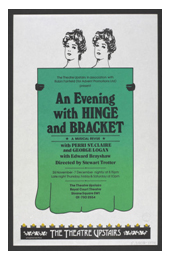 We sat at the back as Campbell directed the rehearsal, much of it improvisation; actors testing and usually rejecting ideas, striving for performable theatrical narrative from challenging material. Heathcote became restless and suggested we look around. We found our way backstage, into the dressing room. The makeup tables were all set out for Doctor Evadne Hinge and Dame Hilda Bracket to prepare for their performance that night. Makeup, wigs and falsies were carefully arranged, but also a bottle of wine, something chichi and German. A stage manager’s note next to the bottle and two glasses stated emphatically that the wine was a prop for the performance and was not to be moved. But they had also left a corkscrew, which Heathcote employed without a moment’s hesitation.
We sat at the back as Campbell directed the rehearsal, much of it improvisation; actors testing and usually rejecting ideas, striving for performable theatrical narrative from challenging material. Heathcote became restless and suggested we look around. We found our way backstage, into the dressing room. The makeup tables were all set out for Doctor Evadne Hinge and Dame Hilda Bracket to prepare for their performance that night. Makeup, wigs and falsies were carefully arranged, but also a bottle of wine, something chichi and German. A stage manager’s note next to the bottle and two glasses stated emphatically that the wine was a prop for the performance and was not to be moved. But they had also left a corkscrew, which Heathcote employed without a moment’s hesitation.
Half an hour later we binned the bottle and went out to see how the rehearsal was going. Campbell had the actors in a huddle that resisted intrusion and Heathcote decided he would rather get some fresh air. In front of the theatre we approached a pedestrian crossing and the driver of a spray-waxed Daimler accelerated across in front of us, making sure that no one impeded his life’s urgency. Heathcote roared with anger and tried to kick the side of the car, stumbling into the road. He ran up after it, greatcoat billowing, shouting obscenities. When the clunky shoes finally tripped him sideways, he barely missed being hit by a taxi.
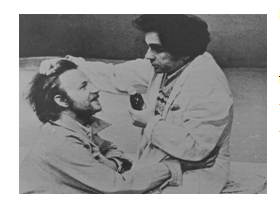 Once he caught his breath, he told me that a contempt for Chelsea squires and their fuckoff sedans wasn’t the reason for his sudden fury. Victor Henry, the actor who had played Perowne in the second, main house production of AC/DC had been in Sloane Square, probably on his way to or from a rehearsal, when he was mortally injured by a car.
Once he caught his breath, he told me that a contempt for Chelsea squires and their fuckoff sedans wasn’t the reason for his sudden fury. Victor Henry, the actor who had played Perowne in the second, main house production of AC/DC had been in Sloane Square, probably on his way to or from a rehearsal, when he was mortally injured by a car.
Henry had also played Jimmy Porter in the Court’s 1968 revival of Look Back In Anger and Jack Shepherd remembered him as “…the epitome of a dangerous actor. When he walked onto the stage, he always reminded me of a gunfighter looking for someone to shoot or, failing that, to bite.”11 AC/DC had been a perfect play for him. Some accounts said the car knocked him down as he waited at a pedestrian crossing, others that the car hit a lamppost, which landed on his head. What’s certain is that he went into a coma and never recovered.
Heathcote suggested lunch in the pub where he and Henry used to sometimes drink. The pub closest to the theatre is now a French themed bistro, but I remember a well-worn and smoke-layered public house where the heating hadn’t been on since before the war. Or maybe we went around the corner to another pub, but there was no food available.
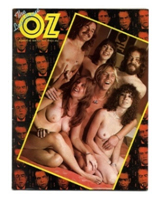 We continued drinking and talked about underground comix, then about Felix Dennis and the demise of OZ; whether the final issue’s cover photograph had been parody, tribute or pure envy of the self-documented orgiastic editorial meetings of Suck newspaper. “More like Health & Efficiency,” he suggested, thinking of how H&E (a favourite read for British naturists and schoolboys) always carefully concealed willies and pussies behind table-tennis paddles and beach balls. Heathcote talked about the work of Robert Crumb and S Clay Wilson and that comix might be the best literary juice to come out of hippie culture. It was from Crumb, of course, that he adopted the name Ruff Tuff Cream Puff for his Estate Agency, a property service for the homeless.
We continued drinking and talked about underground comix, then about Felix Dennis and the demise of OZ; whether the final issue’s cover photograph had been parody, tribute or pure envy of the self-documented orgiastic editorial meetings of Suck newspaper. “More like Health & Efficiency,” he suggested, thinking of how H&E (a favourite read for British naturists and schoolboys) always carefully concealed willies and pussies behind table-tennis paddles and beach balls. Heathcote talked about the work of Robert Crumb and S Clay Wilson and that comix might be the best literary juice to come out of hippie culture. It was from Crumb, of course, that he adopted the name Ruff Tuff Cream Puff for his Estate Agency, a property service for the homeless.
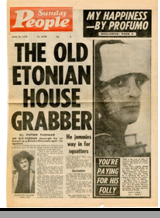 The Agency opened for business after Heathcote organised the liberation of a derelict Bingo hall in Lancaster Road and established The Meat Roxy, a dance and performance venue that became an All Fool’s celebration once a week. It was also a test lab for a full-scale communal Free City of Love, which Heathcote proposed as a type of permanent festival site, created in the countryside, giving people “…the cream of a city’s sensory input without diesel music which causes brain damage, without living in sublimated coffins, without living in streets of ecological carnage…without the open university of tobacco ads, car ads, the decadent marriage of property and sexual elitism.”12
The Agency opened for business after Heathcote organised the liberation of a derelict Bingo hall in Lancaster Road and established The Meat Roxy, a dance and performance venue that became an All Fool’s celebration once a week. It was also a test lab for a full-scale communal Free City of Love, which Heathcote proposed as a type of permanent festival site, created in the countryside, giving people “…the cream of a city’s sensory input without diesel music which causes brain damage, without living in sublimated coffins, without living in streets of ecological carnage…without the open university of tobacco ads, car ads, the decadent marriage of property and sexual elitism.”12
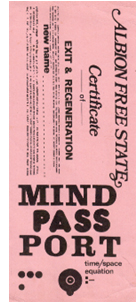 A “visionary” architect, Terry Steward, collaborated on the city’s layout, which Heathcote published in his one-off mimeograph magazine, The Sun Day Head. It included pyramids, a ziggurat, a labyrinth, orgone generators and gardens – a jubilantly radical post-sixties progression of Joan Littlewood’s and Cedric Price’s Fun Palace and Alex Trocchi’s sigma community / spontaneous-university with its “cultural jam sessions”. A scouting party went to check out a possible location – what were believed to be ownerless acres and a derelict farmhouse near Mytholmroyd in West Yorkshire. This was Bell House Farm, which, appropriately, had been the centre of Britain’s most notorious 1700s’ coin-clipping gang, but the Free City occupation was short-lived.
A “visionary” architect, Terry Steward, collaborated on the city’s layout, which Heathcote published in his one-off mimeograph magazine, The Sun Day Head. It included pyramids, a ziggurat, a labyrinth, orgone generators and gardens – a jubilantly radical post-sixties progression of Joan Littlewood’s and Cedric Price’s Fun Palace and Alex Trocchi’s sigma community / spontaneous-university with its “cultural jam sessions”. A scouting party went to check out a possible location – what were believed to be ownerless acres and a derelict farmhouse near Mytholmroyd in West Yorkshire. This was Bell House Farm, which, appropriately, had been the centre of Britain’s most notorious 1700s’ coin-clipping gang, but the Free City occupation was short-lived.
<>
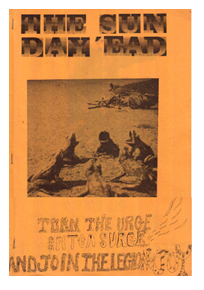 “The mid-winter Saturnalia…Schools closed! Arithmetical slates left quite bare and free from tormented scratchings. War outlawed, Masters waiting upon slaves at the self-same table. The poor all fed and frolicked, including the undeserving poor who are even poorer than the poor…Law Courts bolted up, with indubitable benefit. The whole world turned inside out, downside up, and dusted off…and all for as long as everyone wishes it!”13
“The mid-winter Saturnalia…Schools closed! Arithmetical slates left quite bare and free from tormented scratchings. War outlawed, Masters waiting upon slaves at the self-same table. The poor all fed and frolicked, including the undeserving poor who are even poorer than the poor…Law Courts bolted up, with indubitable benefit. The whole world turned inside out, downside up, and dusted off…and all for as long as everyone wishes it!”13
By the time we left the pub darkness had fallen. Heathcote announced he was going Christmas shopping and asked me along to Harrods, saying we could then share a cab into the West End so I would be closer to King’s Cross and my train back to the North. We walked up Sloane Street and across, me beerily beguiled by the Knightsbridge Christmas lights and fancies; impressed even by the sexed-up allure of Harrods’ window displays.
Rag tattered and half-stewed, Heathcote entered the joint like a prince of thieves. This was when he revealed to me the secrets of his long, baggy coat; its lining of multiple poacher’s pockets. He began browsing wholly unimpressed by affluence’s veneer and beyond its intimidations. He didn’t say whether I was supposed to be a lookout or shield him while he was selecting booty, but there was nothing furtive or hesitant in the way he pocketed his choices, including a large stuffed animal that bulged under the coat.
At one time we were approached by a uniformed shop clerk who asked if we needed assistance and later by a brown-suited thug in heavy store-cop shoes. Heathcote greeted them charmingly and with his most assertive Etonian articulation. Their reactions had a touch of the spellbound, that and the sense of a situation where awkwardness should be avoided at any cost. They smiled and backed off.
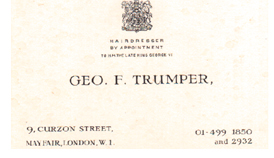 Out of Harrods, Heathcote plump with loot and elated, we took the first taxi in the rank outside the main doors. He instructed the driver to Curzon Street. We were dropped off outside “Trumpers” an exclusive Mayfair barber and pamper parlour favoured by politicians, middling aristocrats and venerable theatricals. I was sent ahead, to distract attention, but when he limped in, a Dickensian deadbeat wreathed in coarse air, he was so courteously received it was if they had been expecting him. But even the “poorer than poor” weren’t going to accomplish any shoplifting here. Heathcote was after a natural sponge and they were all locked in mahogany and glass display cases and surprisingly expensive. Somewhere in his coat he found a wad of tired notes and it took all of them to secure a virginally white sponge the size of a large orange.
Out of Harrods, Heathcote plump with loot and elated, we took the first taxi in the rank outside the main doors. He instructed the driver to Curzon Street. We were dropped off outside “Trumpers” an exclusive Mayfair barber and pamper parlour favoured by politicians, middling aristocrats and venerable theatricals. I was sent ahead, to distract attention, but when he limped in, a Dickensian deadbeat wreathed in coarse air, he was so courteously received it was if they had been expecting him. But even the “poorer than poor” weren’t going to accomplish any shoplifting here. Heathcote was after a natural sponge and they were all locked in mahogany and glass display cases and surprisingly expensive. Somewhere in his coat he found a wad of tired notes and it took all of them to secure a virginally white sponge the size of a large orange.
At the time I wondered whether Heathcote might have once been a Trumpers’ customer, in a time before he decided to release his hair back to nature, allegedly testing its unmanaged tangle as sensory antennae for unknown energies. It was the type of barbers where the narcissistic Harold Pinter might have sought grooming, once success came to him, and therefor might have been where the writing of The Local Stigmatic got underway. “I was young and had just written a book about the speakers at Hyde Park Corner, which Pinter reviewed in the Observer, writing: ‘These are the only people I’d ever want to listen to.’ Not long after, I found myself sitting next to him in the barber shop and thanked him for his review. Harold said: ‘Have you ever written a play? I know someone on the BBC Third Progamme.’”14
The week after our afternoon in London I received a “comp” for the Truth Dentist opening night. His instruction to the box office was on the reverse side of a flyer for the show. In a note he reminded me how much he had disliked the Royal Court’s official poster; which he regarded as consciously cool and urbane, the sort of Warhol pastiche that weekend hippies would buy in a Big O Poster shop. The Truth Dentist had designed his own.
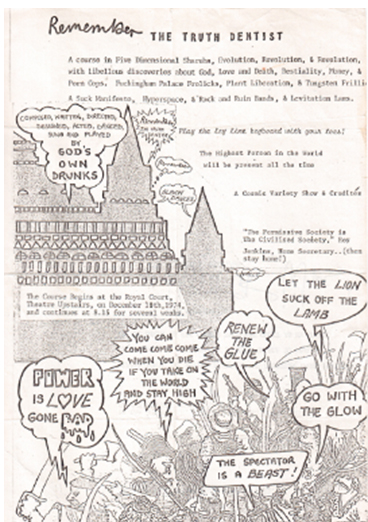
.
Images: Heathcote Williams at 217a Westbourne Park Road (undated) – photo by Jay Jeff Jones; Royal Court poster for Remember the Truth Dentist; Transatlantic Review 14 (1963); Royal Court poster for An Evening with Hinge and Bracket; Victor Henry as Perowne and Henry Woolf as Maurice in AC/DC (1970); OZ – The Last Issue (1973); front cover of Sunday People (June 15, 1975); “ticket” for the Meat Roxy (undated); The Sunday Head, mimeograph magazine by Heathcote Williams (undated); Geo. F. Trumper business card; Remember the Truth Dentist poster / flyer by Heathcote Williams (December 1974).
References:
- Wardle, Irving, “An Interview with Heathcote Williams”, Gambit 18/19, (London) Calder & Boyars, 1971.
- Worth, Katherine J., Revolutions in English Drama, (London) G Bell & Sons, 1973
- Rokeach, Milton, The Three Christs of Ypsilanti, (New York) Knopf, 1964
- Letter from Heathcote Williams to Katherine Worth (undated)
- Williams, Heathcote, AC/DC, in Gambit 18 & 19, (London) Calder & Boyars, 1971
- Charles Marowitz was an expatriate American who worked with Peter Brook in the Royal Shakespeare Company’s Theatre of Cruelty season (1964), and became, during the sixties and seventies, one of London’s most buccaneering underground theatre directors. He also directed the second, highly successful London production of Joe Orton’s Loot in 1966.
- Shearman, Colin, “Thirty years on, Heathcote Williams’s AC/DC is still an electrifying experience” the Guardian. 16 June 1999
- Sontag, Susan, “Approaching Artaud”, The New Yorker, May 1973
- At the Royal Court, Richard Findlater, (London) Amber Lane Press, 1981
- “An Interview with Heathcote Williams”, Gambit 18/19.
- Shepherd, Jack, “Don’t Talk About it – Do It” in At the Royal Court
- Williams, Heathcote, The Sunday Head, self-published, undated.
There is a legacy here, of course, not just the Diggers’ moneyless Cockaigne but a longstanding avant-gardist idealism including a Dada declaration from 1919:
“The immediate expropriation of property (socialization) and the communal feeding of all; further, the erection of cities of light, and gardens that will belong to society as a whole and prepare man for a state of freedom…” Richard Huelsenbeck and Raoul Hausmann, “What is Dadaism and what does it want in Germany”.
- Heathcote Williams’ voice on loan to the character of John Dickens, father of Charles, in his television script What the Dickens! These lines were edited out of the televised version in 1983.
- Interview with Nancy Groves, Guardian, 12 May 2016
Or perhaps it didn’t happen like that. In another memoir of Pinter, published by Cold Turkey Press (2014), Heathcote wrote that the invitation had been extended on a day he was visiting Pinter at his flat in Gloucester Road.

What a great piece! Can’t wait for Part II and any other parts that Jay Jeff Jones has up his sleeve.
Comment by Jan Herman on 23 December, 2018 at 3:33 pmJones takes us on an unplanned walk through London to a rehearsal of AC/DC alongside his acquaintance Heathcote Williams, a man whose hair and mind always seemed to be in a state of outraged astonishment. What a lot of fun to remember this kind of encounter, one we all may have once experienced, but can no longer remember because it was later drowned by best bitter and a foggy hat memory.
Comment by Tom Ruffles on 23 December, 2018 at 5:54 pmThe finest paean of praise to Heathcote – so far!
Comment by Cy Lester on 31 December, 2018 at 2:51 pm[…] This essay first appeared in slightly different form in International Times. […]
Pingback by Remembering the Truth Dentist: Heathcote Williams by Jay Jeff Jones • Empty Mirror on 17 May, 2019 at 2:45 pm[…] He published short stories in Transatlantic Review, where he struck up a friendship with Heathcote Williams, and also wrote for alternative and underground magazines, among them International […]
Pingback by A Proper Obituary for Jay Jeff Jones (1946-2023) | Straight Up | Jan Herman on 15 July, 2023 at 6:04 pm